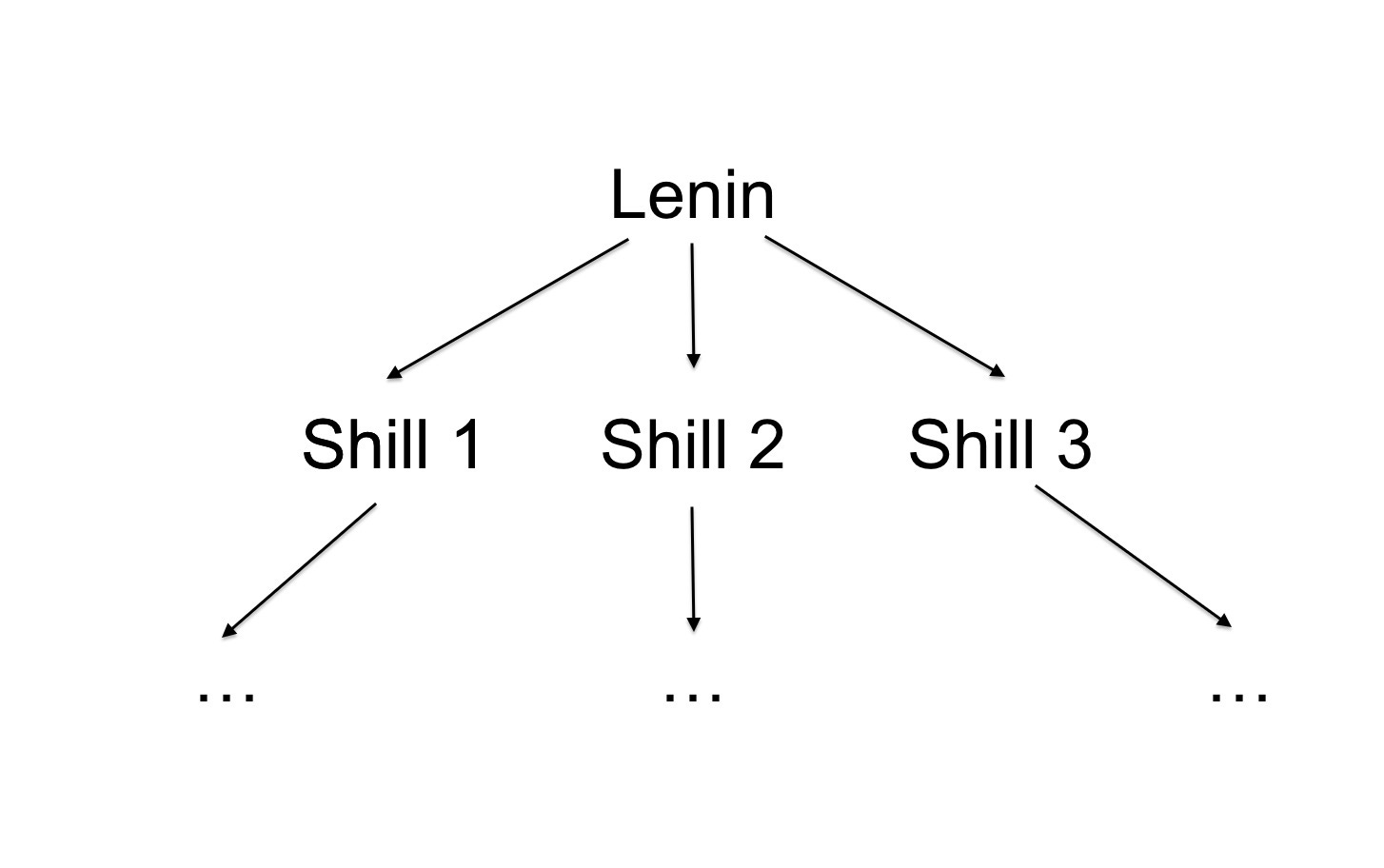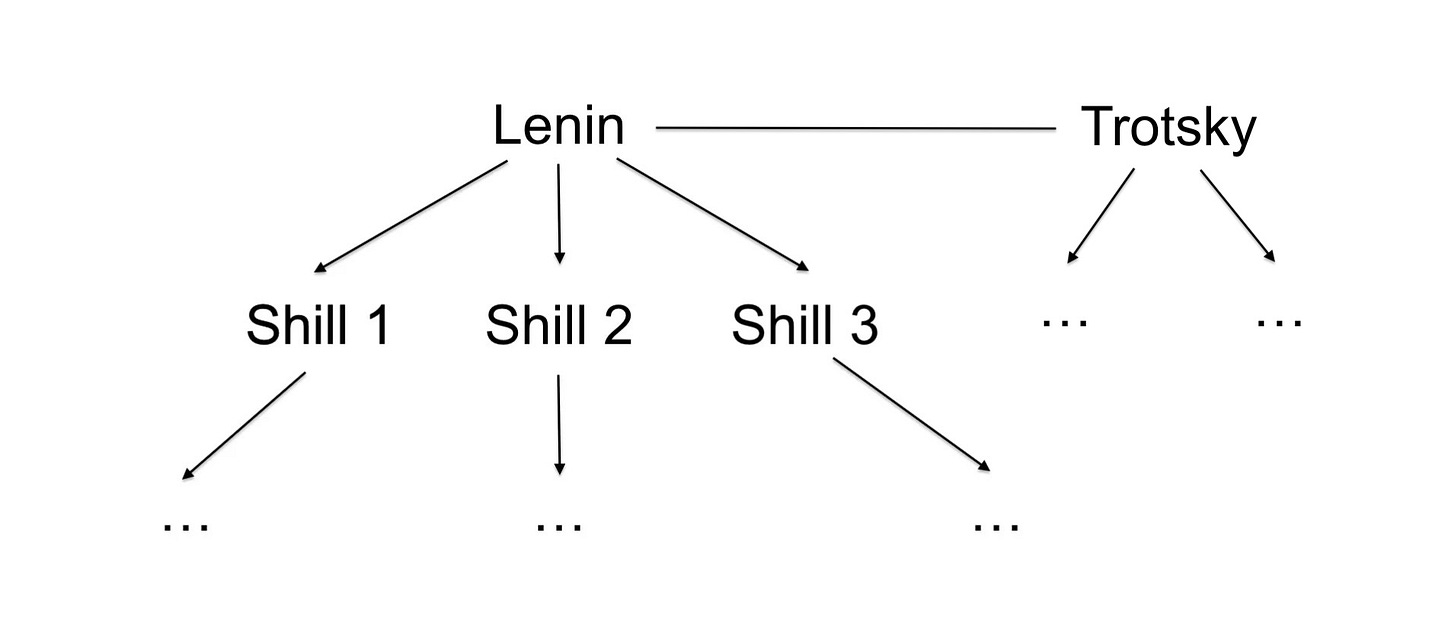Formally, leadership of the Communist Party could be a flat structure. It had about a dozen members, of equal status and equal rights1. They voted, and their vote directed the course of the Party. That is how it worked on paper.
Informally though, the situation was different. One person controlled the upper ranks of the Party through his personal, informal network of vassalage. That was Vladimir Lenin. So, while theoretically, Politburo consisted of equally important people of the same rank, in reality it consisted of shills and vassals of Lenin2.
Informal structure of the Party leadership
Please notice, that Lenin’s position was not formalised on paper:
Lenin’s power = his sociometric status in the informal network of contacts
Technically, everyone has the same rank. Informally, all are subordinate to the Old Man.
Were there any exceptions from the rule? Yes
The main exception was Leon Trotsky. That was the only man in the entire Bolshevik leadership who was not a Lenin’s vassal. Everyone else were Lenin’s shills and pawns. Trotsky was not. He was an ally of Lenin rather than his vassal. He was the only person who could even try to talk with Lenin from the position of parity.
Why Trotsky was different
To start with, Trotsky was not an old Bolshevik. He was a leader of an independent faction3 that had long quarrelled with Lenin an Leninists, throwing mutual accusations, and disowning them repeatedly.
Trotsky did not join the Bolsheviks until July 1917. The timing is crucial. That was the very bottom of Bolshevik history, their lowest point. They had just raised an armed insurrection (which was massacred by the government), and, after its suppression, were left in a complete disarray, scattered and demoralised.
That was the time when Trotsky made a final decision to merge with the (defeated, persecuted) Bolsheviks. Joining the Bolsheviks at their lowest point, Trotsky joined them on very favourable terms4.
Now this explains peculiarity of Trotsky’s position in the Bolshevik structure
Trotsky stands extremely high and extremely isolated
On the one hand, he stands uniquely high. He is the only man to whom Lenin talks from the position of parity. An ally, rather than a disciple or a shill.
One the other hand, he is uniquely lonely. In the entire Politburo, he stands alone, as an outcast. Everyone else either belongs to the Lenin’s network or bent the knee to it.
Why would such a strange structure emerge, in the first place? Because of necessity
At the bottom point of summer 1917, at the very nadir of Bolshevik movement, Lenin was desperate for allies.
So when Trotsky threw his lot with the Bolsheviks, Lenin would not refuse. He co-opted Trotsky and co-opted him on very high status.
That was a necessary alliance, that proved crucial both in the revolution and in the civil war. The energy, the courage, the intellect and personal charisma of this Lenin’s ally were instrumental in securing the Bolshevik victories
Yet, it is necessary to remember that this was a temporary alliance only. With the last gunshots of the Civil War, Lenin-Trotsky alliance started fracturing
There were good reasons for that
The name of Trotsky has risen too high. The enemies saw him as a leader of Bolshevik, on pair or even above Lenin.
What is worse, the own file and rank of the Party was of the same opinion
Through the revolution and civil war; the party ranks grew many fold. The old, pre revolution core (the Inner Party) was absolutely outnumbered by the new recruits (the outer party) who did not know and did not remember any ideological and theoretical fights that defined the pre revolutionary period
Recruited after 1917, they saw Trotsky as the leader. The most brilliant, the most popular, the most charismatic of the Bolsheviks.
Naturally, it incited the jealousy and the wrath among the old, pre revolutionary Bolshevik core that occupied almost all the important positions of power
Consider Politburo. The supreme governing body of the Communist Party includes about 9 of Lenin’s shills. But it does not include anybody of Trotsky’s. Trotsky has his own vassals, of course. But in Politburo, specifically, he stands completely isolated, outnumbered ten to one.
Keep reading with a 7-day free trial
Subscribe to kamilkazani to keep reading this post and get 7 days of free access to the full post archives.








